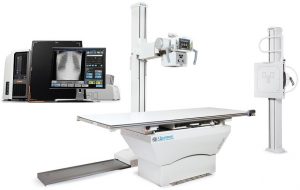Direct digital radiography (DDR) systems are replacing film/screen radiography for general radiographic examinations in many hospitals and its use is likely to rapidly increase with the national programme for the installation of picture and archiving systems (PACS) across the NHS, scheduled for completion in 2007.

This report summarises evaluation data on a range of digital detectors: Canon CXDI-31, Delft ThoraScan, GE Revolution, Hologic DirectRay, SwissRay dOd HP and Trixell Pixium 4600.
The pre-sampled modulation transfer function (MTF) shows the faithfulness of the transmission of the incoming signal of the detector. The Hologic has a much better MTF than the others while the Delft is poorer in the scan direction of the scan array and there is a slight difference between directions for the SwissRay which uses lens and mirror coupling.
The Hologic detector also has a very different normalised noise power spectra (NNPS) frm the others, with good transmission of high frequency information but also of high frequency noise. But all of the detectors are satisfactory for measurements of detective quantum efficiency (DQE).
The GE Revolution an dthe Trixell Pixium 4600 have the highest peak of DQE of the six detectors. The Hologic DirectRay shows variability of DQE with dose, which indicates significant structural noise in the image.
